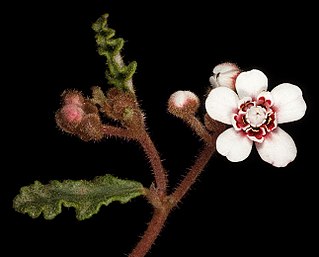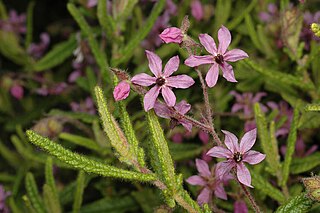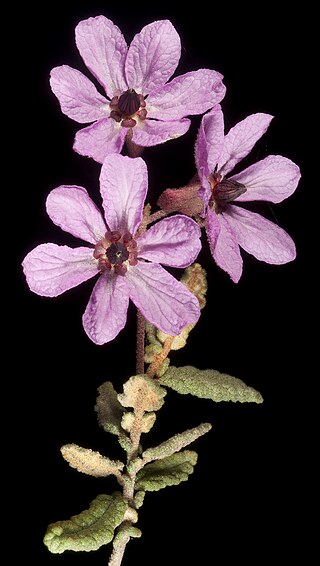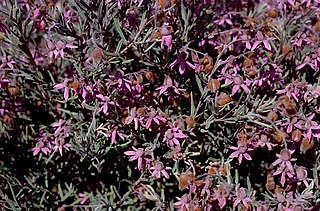
Thomasia sarotes is a species of flowering plant in the family Malvaceae. It is an upright, spreading shrub with purple, pink to mauve or white flowers and is endemic to the south-west of Western Australia.

Thomasia pygmaea, commonly known as tiny thomasia, is a species of flowering plant in the family Malvaceae and is endemic to southern Western Australia. It is a low, dense, compact shrub with broadly heart-shaped to egg-shaped or more or less round leaves and pink to purple flowers.

Guichenotia macrantha, commonly known as large-flowered guichenotia, is a species of flowering plant in the family Malvaceae. It is a shrub with grey-green leaves, mauve flowers and is endemic to Western Australia.

Leptospermum oligandrum is a species of erect, spreading shrub that is endemic to the south-west of Western Australia. It has broadly egg-shaped to wedge-shaped leaves, white flowers arranged singly or in groups of up to three on the ends of short side branches and fruit that fall from the plant shortly after the seeds are released.

Androcalva pulchella is a species of flowering plant in the family Malvaceae and is endemic to the south-west of Western Australia. It is a small shrub with egg-shaped, elliptic or oblong leaves, the edges wavy, lobed or toothed, and clusters of two to seven white and deep pink flowers.

Lysiosepalum abollatum, also known as woolly lysiosepalum, is a species of flowering plant in the family Malvaceae and is endemic to a small area in the south-west of Western Australia. It is an erect, dense shrub covered with white, woolly hairs, and has narrowly egg-shaped leaves and pink, blue or purple flowers usually in groups of four or five.
Lysiosepalum hexandrum is a species of flowering plant in the family Malvaceae and is endemic to the south-west of Western Australia. It is dense, erect shrub with its young branches covered with woolly, star-shaped hairs, and has linear or narrowly elliptic leaves and blue, purple or pink flowers usually in groups of five.

Lysiosepalum rugosum, also known as the wrinkled-leaf lysiosepalum, is a species of flowering plant in the mallow family and is endemic to the south-west of Western Australia. It is shrub with its young branches covered with woolly, star-shaped hairs, and has narrowly egg-shaped leaves and blue, purple of pink flowers usually in groups of 4 to 6.
Hibbertia verrucosa is a species of flowering plant in the family Dilleniaceae and is endemic to the south-west of Western Australia. It is a shrub with scattered, densely hairy, narrowly rectangular leaves and yellow flowers usually with ten stamens fused at the bases, all on one side of two densely softly-hairy carpels.
Daviesia pachyloma is a species of flowering plant in the family Fabaceae and is endemic to the south-west of Western Australia. It is an erect, bushy or spreading shrub with zigzagging branches, sharply-pointed, narrowly elliptic to linear phyllodes, and yellow and red flowers.

Thomasia brachystachys is a species of flowering plant in the family Malvaceae and is endemic to the Southwest Australia south-west of Western Australia. It is an open, erect shrub with egg-shaped to heart-shaped leaves and pink to mauve flowers.

Thomasia rhynchocarpa is a species of flowering plant in the family Malvaceae and is endemic to the Southwest Australia south-west of Western Australia. It is an erect, slender shrub with narrowly egg-shaped leaves with a heart-shaped base, and pink to purple flowers.

Thomasia rugosa, commonly known as wrinkled leaf thomasia, is a species of flowering plant in the family Malvaceae and is endemic to the south-west of Western Australia. It has wrinkled, lance-shaped to egg-shaped leaves with wavy edges, and pink to mauve flowers.

Thomasia stelligera is a species of flowering plant in the family Malvaceae and is endemic to the south-west of Western Australia. It is a low, spreading shrub with scattered, narrowly oblong leaves, and racemes of mauve flowers.
Androcalva cuneata is a species of flowering plant in the family Malvaceae and is endemic to the south-west of Western Australia. It is a low, spreading, densely hairy shrub that sometimes forms suckers and has wedge-shaped leaves and clusters of 5 to 15 pink flowers.

Commersonia densiflora is a species of flowering plant in the family Malvaceae and endemic to the south-west of Western Australia. It is a dense, low-growing shrub with pinnate, elliptic to narrowly oblong, prominently veined leaves, and white flowers in clusters of 100 or more.
Commersonia rotundifolia, commonly known as round-leaved rulingia, is a species of flowering plant in the family Malvaceae and endemic to the south-west of Western Australia. It is an upright, openly-branched shrub with elliptic to round leaves with wavy edges, and white flowers in clusters of 3 to 10.

Androcalva crispa, commonly known as crisped leaf commersonia, is a species of flowering plant in the family Malvaceae and is endemic to the south-west of Western Australia. It is a prostrate shrub that forms suckers from rhizomes and has densely new growth, clusters of lobed, egg-shaped or oblong leaves with wavy, serrated edges, and groups of white and pinkish-purple flowers.
Androcalva incilis is a species of flowering plant in the family Malvaceae and is endemic to the south-west of Western Australia. It is a prostrate shrub with dark green, narrowly wedge-shaped to narrowly oblong leaves, and crowded heads of 8 to 12 deep pink flowers.

Guichenotia angustifolia is a species of flowering plant in the family Malvaceae and is endemic to the south-west of Western Australia. It is an erect, prostrate or climbing shrub with hairy young growth, hairy, oblong to linear leaves and pink to mauve flowers.














